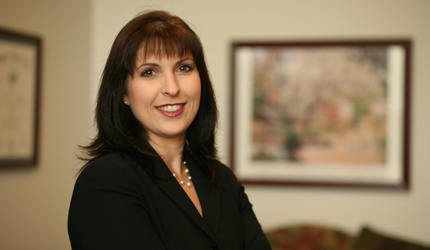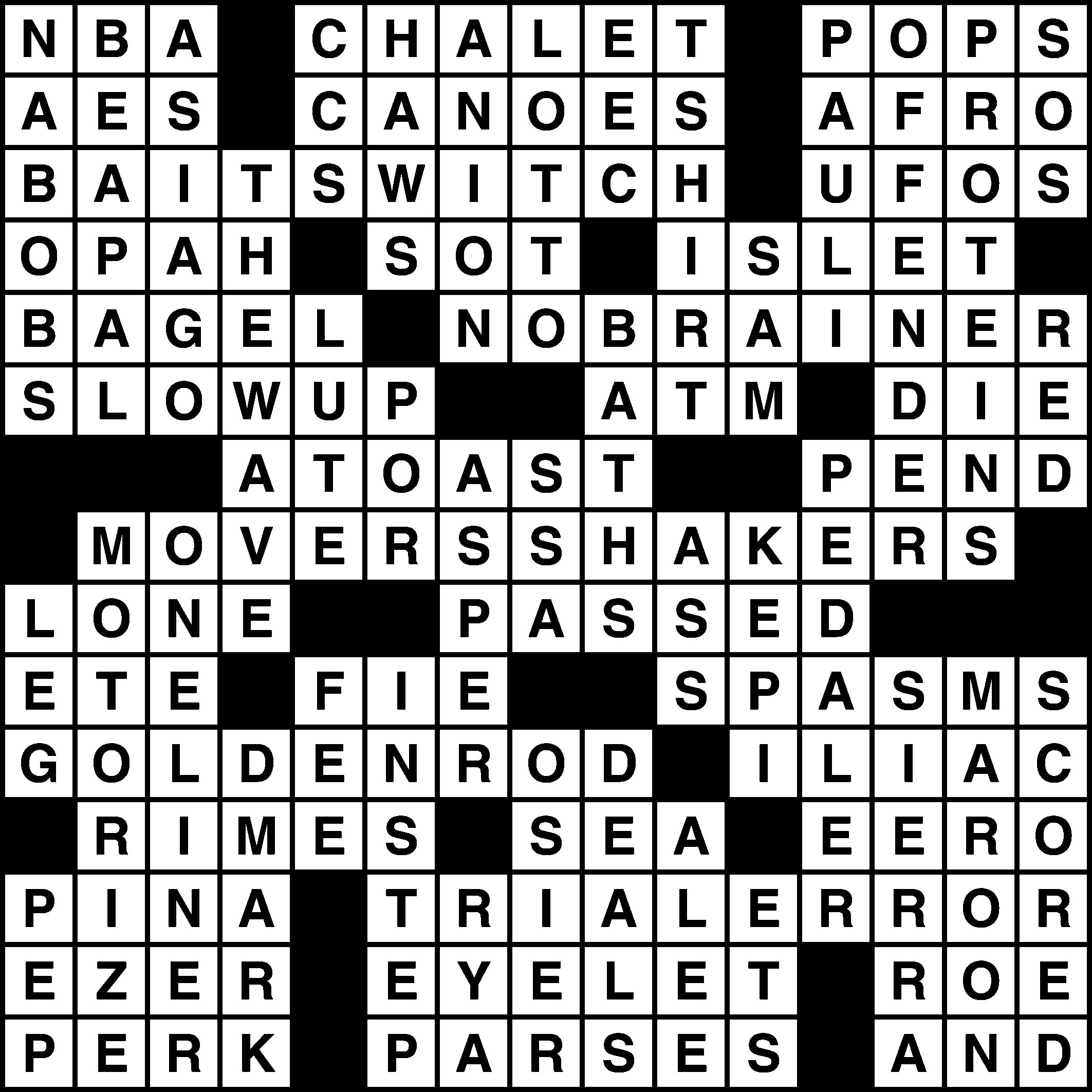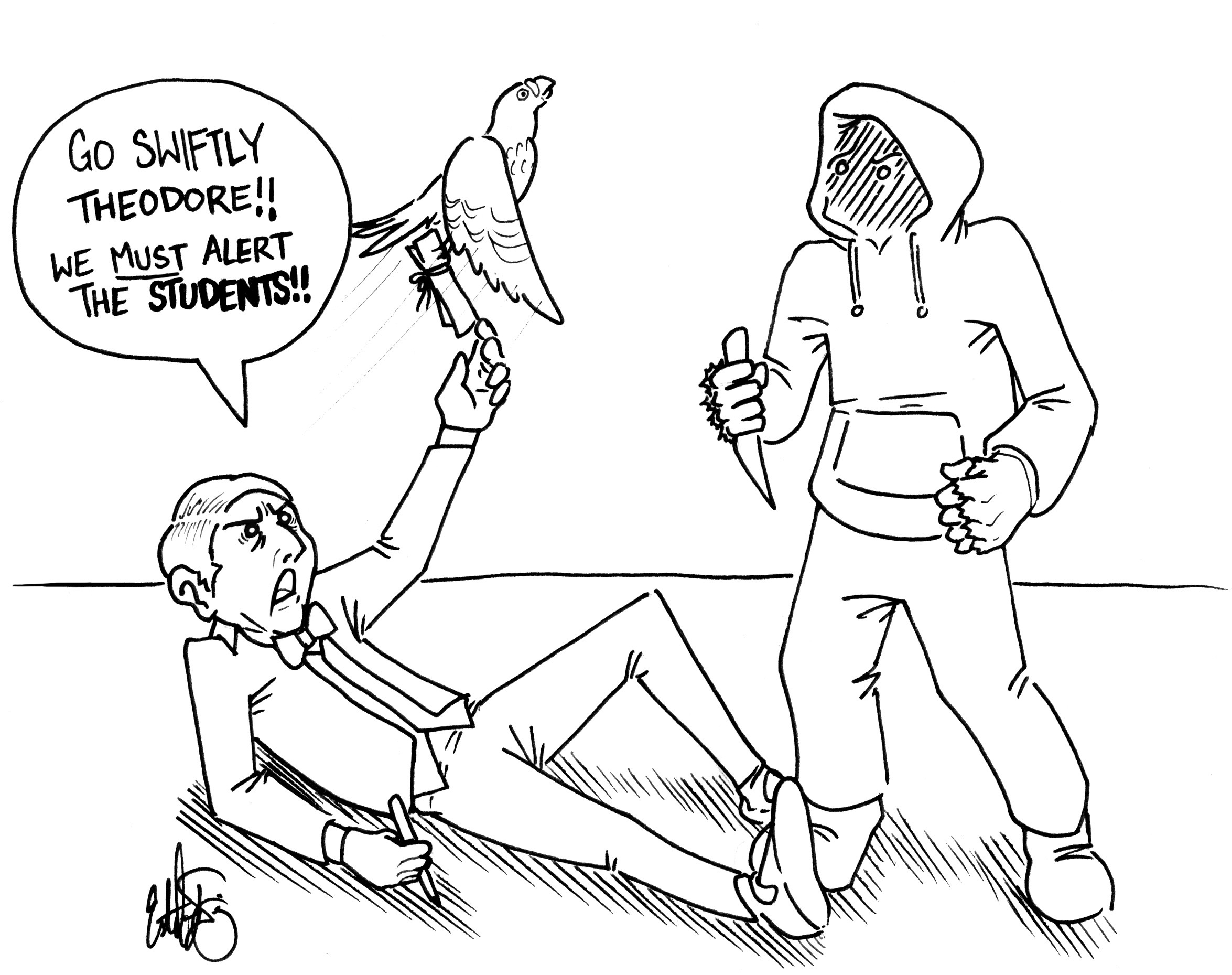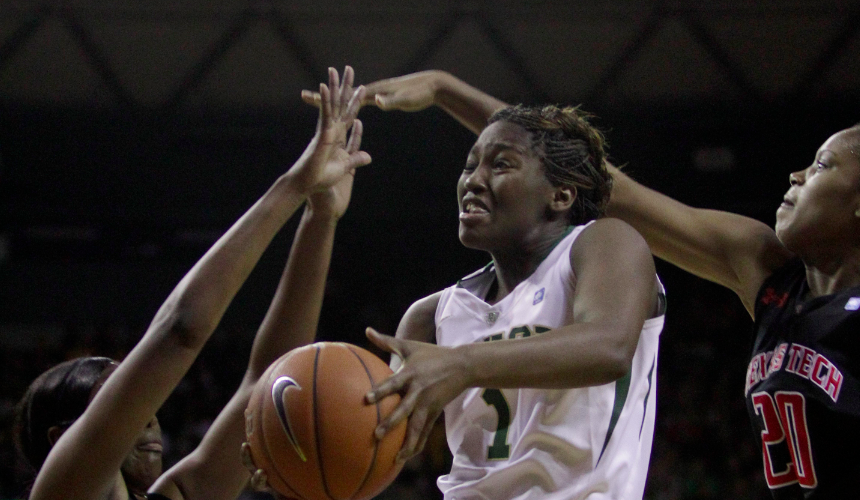[issuu autoFlip=true width=640 height=560 embedBackground=%23005fbb shareMenuEnabled=false backgroundColor=%23222222 documentId=110127064848-1a85b076764d4e638055355a4c42e156 name=110127pdf username=jonangel tag=news unit=px v=2 showhtmllink=false]
National alumni speak out
Strategic sessions planned in 12 U.S. cities
By Sara Tirrito
Staff Writer
Baylor alumni will come together to share their ideas regarding the university’s future at strategic planning community input sessions in 12 cities across the nation, beginning this week. The sessions will conclude in April.
“These sessions are a vehicle to allow folks to come together and as a group to exchange ideas with other folks who care about Baylor University and care about the future of Baylor University, and then to have those responses recorded and be part of the official input to the strategic plan,” Dr. Elizabeth Davis, executive vice president and provost, said. Davis is leading the strategic planning efforts.
The first strategic planning input session took place Tuesday in Atlanta at Johnson Ferry Baptist Church.
Sessions will be held Thursday in Waco and San Antonio. The Waco session will be held from 6 to 7:30 p.m. on the fifth floor of Cashion Academic Center. The San Antonio session will be held at 6:30 p.m. at Trinity Baptist Church.
“I’m really excited that we get to have the chance to go to a large number of cities where our alumni and other friends of the university live and really just listen,” Tiffany Hogue, assistant provost for institutional effectiveness, said. “We want this to be a really collaborative and inclusive process and part of that is us going on the road to hear from people across the country.”
In order to attend the sessions, alumni are asked to register online to ensure the venue is large enough to hold all of those attending, and to ensure that adequate refreshments are provided. However, alumni who do not register can still attend the sessions and give their input.
By Monday, 170 people had registered for the Waco session, necessitating a move from the planned venue of the Great Hall in the George W. Truett Theological Seminary, which has a capacity of 120, Davis said.
“I am extremely thrilled by the level of interest that I’ve seen in these input sessions,” Davis said. “People are e-mailing me and calling me, thanking me for providing this opportunity, asking if they can volunteer to help. The response has been really affirming that this is a right thing to do as we are considering Baylor’s next strategic plan.”
Ashley Thornton, director for continuous improvement, said that since Baylor belongs to so many groups of people, from students, faculty and staff to the state, country and world at large, it is important for each group to be able to share its opinions concerning Baylor’s future.
“Each one of those groups it belongs to are going to have a different perspective on what we need to be doing for the next 10 or 15 years or even ultimately, and I think it would be hard for any one of those groups to totally understand or imagine what the other groups are going to care most about,” Thornton said. “So that’s why it’s important to get kind of a full circle of input from as many different stakeholders as we can think of that care about Baylor.”
Other cities that will be hosting community input sessions include Houston, Dallas, Amarillo, Lubbock, Austin, Nashville, Tenn., Chicago, Washington, D.C., and Los Angeles. These cities were chosen because of their large concentrations of alumni.
Dr. Patricia Tolbert, director of assessment and compliance, said seeking input from alumni nationwide is an important part of the strategic planning process.
“I think we have to do that. I think Baylor is such a national school now and we have alumni everywhere who still care very much about Baylor and are still interested in Baylor’s future, and as Baylor continues to build its reputation it enhances their degree,” Tolbert said.
“I think we need to make sure that we’re getting their input and let them know that we’re still very interested in what ideas they have for improving Baylor.”
At the sessions, attendees’ ideas will be written down, and the sessions will also be tape recorded and transcribed to ensure that no input is overlooked, Davis said. The results of these sessions will later be analyzed along with all other input gathered throughout the process, such as that given online.
Sell-Off forces students to sharpen sales skills
By Molly Packer
Reporter
The second round of the Baylor Business Sell-Off will test six students’ ability to market the benefits of products to potential customers.
Chris Cude, Dave Games, Ben Kessler, Will May, Samuel Moore and Sarah Shive will compete today for top spots on the team. The top two team members will move on to compete at Kennesaw State University in Kennesaw, Ga., against top students from around the nation.
“You get a scenario, a case, a week before and you have to make a script,” Austin senior Games said. “They bring in buyers, usually from companies, and there is a 20-minute role play recorded with cameras in the room.”
The recordings are distributed to companies that rank and give feedback to each of the contestants.
The companies that help judge the competition often offer jobs to the best competitors. Although nothing is guaranteed, competing in the Sell-Off often allows students to put their foot in the door.
“This is something that [represents] me that is being sent out to a lot of people who I’m applying to,” Games said. “It’s a lot of work for a 20-minute conversation.”
One of the hardest things for the competitors is time management. “It’s always such a busy time. [The competition is] right when we get back into classes and we have Sing,” said Shive, a North Richland Hills senior. “We’re all really involved elsewhere. We have a lot of commonality because we are so involved.”
Through all the chaos and late hours, the team is thankful for the work Dr. Andrea Dixon, associate professor of marketing, puts into the program.
“For every hour of work we do, she does four,” Shive said. “She’s obviously very successful in what she does and it makes me want to do the same.”
Though the Baylor Business Sell-Off is a simulation experience, in just a few months the graduating seniors of the team will be fully immersed in the business world. After going through the experience of the Business Sell-Off, members of the team say they are confident in their future outside of Baylor.
“I definitely want to be involved in sales. Honestly, international sales would interest me,” said Highlands Ranch, Colo., senior Kessler. “As far as what I want to sell, as long as it allows me to travel.”
Shive also hopes to continue in sales.
“I’m definitely going to work in sales, which I never thought I would say. I really like the idea of working with the government and nonprofits, so I’ll learn a lot about fundraising,” Shive said. “You don’t have to go door-to-door selling vacuum cleaners.”
Games plans on going into the technology industry to be a salesman.
“[I want to be] an account manager. Most times in sales you have to start out inside sales, on the phone,” Games said. “[I’ll] start off in a position to learn. Because, believe it or not, we’re not going to graduate college knowing everything whether we think so or not.”
Some of the team members, like many others in the business world, did not initially think business was in their future.
“I started out business pre-med. I like science but I realized I didn’t want to be a doctor,” Games said. “I like the creativity involved in marketing. Most of my decision was based on the curriculum and Dr. Dixon.”
Kessler’s parents both worked in business and he knew before arriving at Baylor that business was for him. Professional selling, however, was not always part of the plan.
“Sophomore year I was looking at majors and didn’t want to do accounting or finances. I wanted to do stuff with people,” Kessler said. “[Professional selling] is exactly what I wanted to do. I just realized that God had me here for a reason.”
Editorial: The Flatlining of Higher Education
Higher costs, less learning and increased apathy — those are the afflictions of higher education. Scholars have begun to delve into these problems and the findings are astounding. Yet still, the people within academia aren’t reacting because money is still flowing in and college is still enjoyable. We have to alter the system and we should start now.
A recent study of survey responses, transcript information and data from the Collegiate Learning Assessment concluded that 45 percent of students tested after their second year in college showed no improvement in their development of “higher-order cognitive skills.”
This finding is the basis of the soon-to-be-released book, Academically Adrift: Limited Learning on College Campuses. The book is a compilation of the findings of researchers who followed 2,300 undergraduates through four years of college at 24 unidentified higher education institutions to measure the progress of the undergraduates’ critical thinking and analytic reasoning skills.
Dr. Richard Arum, a professor of sociology and education at New York University and director of the Education Research Program of the Social Science Research Council, and Dr. Josipa Roksa, an assistant professor of sociology at the University of Virginia, are both authors of the book set to be published by the University of Chicago Press this month.
A portion of the experts’ book was published on the Chronicle of Higher Education website, in which the two discuss the book, the data and why college students aren’t improving.
The debate on the costs of higher education and how the system can be improved has been a heated topic for years. From students too focused on their social lives to professors focused on individual research, the authors have found that the very people within the higher education system aren’t focused on a remedy to the problems. Even worse, Arum and Roksa say that some may not even notice the problems, writing that college students “define and
understand their college experiences as being focused more on social than on academic development.”
But a developed social aptitude certainly has its perks and should not be considered the sole reason students are not learning.
Students leave college with strong friendships and lasting memories. They have learned to depend on others, to value friendship and to live independently.
However, when they leave college they don’t entertain the thought that their cognitive skills may have never developed.
It is far easier for self-reflective people to view their social progress. A person’s intellectual progress, however, is a much more difficult aspect to examine.
It is ridiculous to say that all students only come to college for the social growth. Perhaps students believe they have intellectually grown from college when in fact, because of the ease of college courses, they have not.
The workload of college courses has a dramatic effect on the amount a student improves. The study proves that students whose classes reflect high expectations (more than 40 pages of reading a week and more than 20 pages of writing a semester) developed their cognitive skills more than other students. Therefore, those teachers who underestimate the work ethic of the current student population may be helping the final grades of their course but they are in no way improving the overall education of students.
It is clear that several factors are contributing to the stunted academic growth in higher education. However, it all boils down to the truth that there isn’t enough people who care to work toward a solution.
“Students in general seek to enjoy the benefits of a full collegiate experience that is focused as much on social life as on academic pursuits, while earning high marks in their courses with relatively little investment of effort. Professors are eager to find time to concentrate on their scholarship and professional interests. Administrators have been asked to focus largely on external institutional rankings and the financial bottom line. Government funding agencies are primarily interested in the development of new scientific knowledge. In short, the system works. No actors in the system are primarily interested in undergraduates’ academic growth, although many are interested in student retention and persistence.”
The problem lies here: No one is focusing directly on the quality of our education — not students, professors, administrators or faculty. How can we, as a nation that once stood as the archetype of higher education success, continue to allow money and politics to steal from future generations’ well being? This research has pinpointed the glaring flaws of higher education and is sure to spark much discussion and hopefully change. However, many aspects of the current academic realm go untouched in this study, such as the major role digital technology has played on our generation’s development. Despite our simultaneous growth with the digital world, numerous professors refuse to incorporate any form of technology into their courses. It is absurd to think that teaching styles should never change. In fact, the easiest way to attempt to remedy this problem of “no-growth learning” is to ask those who have committed their lives to educating collegiate scholars to tap into their classes and discover what is and is not working. It seems as if some professors expect all students to conform to their generation’s methods rather than discerning the appropriate way to teach for the new generations.
As we become more dependent on technology, courses should not continue to refuse the integration of technology. However, simply accommodating for technology will not solve our problems either. If digital textbooks are supposed to offset the cost of high education, then will an increased reading load truly benefit? Therefore, colleges should focus on the ability to fully teach a course rather than the ability to offer the course at a lower cost. Until the realm of higher education has decided to embrace technology, this balancing of pros and cons will drone on.
The collegiate balance is severely off-kilter. There are so many problems to fix and several theoretical remedies. What’s missing is action. What was once a highly efficient system that churned out bright young minds and innovative ideas is now nearing mass chaos. However, as Arum and Raksa say in their book, we can’t classify this problem as a “crisis” because no one seems to be treating it as such. That is, many people are sitting idle. Administrators are still bringing in money, students are enjoying their college years and professors are still focusing on personal research. Until the higher education constituency bans together and resolves to fix our broken system, we may be headed downhill to a fate that is, at best, mediocre and, at worst, a failure. It shouldn’t take failure to get us motivated.
It should take the fact that some students are leaving institutions that proclaim a mission of education without showing any improvement. That is failure. And it should be unacceptable. We need passion. We need drive. We need a new mindset.
BU couple tackles marriage ministry

Brandon and Elizabeth Oates, who met at Baylor, designed a ministry to help people of all ages who are affected by family problems and divorce.
By Stori Long
Reporter
Theologian Frederich Buechner said that vocation “is the place where your deep gladness and the world’s deep hunger meet.” For two Baylor alumni, this has proven to be all too true.
Husband and wife team Brandon and Elizabeth Oates have combined their mutual heart and passion for ministering to those who come from broken homes to create Project Restoration, a ministry created and maintained by the couple.
“Brandon and I got the idea when he and I went on a 24-hour retreat, just the two of us, and just prayed about what God wanted from us,” Elizabeth said. “The idea behind the whole ministry is that just because you’ve had some hard issues in the past doesn’t mean you can’t have a functional future.”
The couple, who married in 2001, designed the ministry to help people of all ages who are affected by problems arising from a dysfunctional family background. They created a website to further the ministry, which includes the testimonies of the couple, a list of speaking topics and speaking events. It also has resources such as a six-week study for teenagers written by Elizabeth called “Dealing with Divorce.”
“There is so much divorce recovery resources for adult, and even young children, and so little for teenagers,” Elizabeth said. “I thought that someone needed to speak up for them.”
Elizabeth and Brandon also teach a class for engaged and newlywed couples through Legacy Family Ministries. The class is held at Harris Creek Baptist Church in McGregor, where the couple continually sees the impact of coming from a broken home.
“We see so many young couples who come from broken homes and they have so many questions like ‘Am I doomed to get a divorce?’ or ‘Do I have to go down the same path my parents did?’” Elizabeth said.
Brandon echoes the desire to help young couples dealing with these questions.
“A lot of these couples are dealing with unfortunate circumstances, but it’s stuff that can usually be fixed. But it’s stuff that if it doesn’t get fixed, it only gets worse,” Brandon said. “It takes time, patience, the Lord and a Christ-centered relationship.”
Much of the inspiration for the couple’s ministry came from their own lives and their own marriage. Brandon and Elizabeth met at Baylor, but the two came from very different family backgrounds.
“We both came into marriage with very different ideas,” Brandon said. “Elizabeth’s parents were divorced and mine were married for 37 years. She came into marriage having seen the brokenness and I came in never seeing the problems. This made the first year very difficult.”
The differing expectations the two held created tension in the first years of marriage. However, when the two started speaking to other couples, they came to realize this was a common problem in marriage and they were not alone in these issues.
Elizabeth also does numerous speaking engagements on family and marriage issues and she and Brandon both serve as life group leaders at Harris Creek. Elizabeth also writes a monthly column for Waco Today on faith and family issues.
“Elizabeth is very driven and extremely intelligent. She’s the type of person who can seemingly do anything,” Meredith Miars, a member of Harris Creek, said. “She’s just so passionate and so compassionate about the young couples she counsels.”
Brandon shares this admiration for his wife and her devotion to ministering through her writing.
“I am more involved in the marriage counseling,” Brandon said. “She has a more active role in the ministry, but I’m definitely her number one fan.”
At the core of Elizabeth and Brandon’s ministry is the desire to show those they reach that there is always a second chance.
“We want all people of all ages to know that God is a God of restoration,” Elizabeth said. “He makes beauty from ashes.”
Anyone interested in Brandon and Elizabeth’s ministry can visit www.projectrestorationministry.org for more information.
Revived pitching staff returns to outdoor work
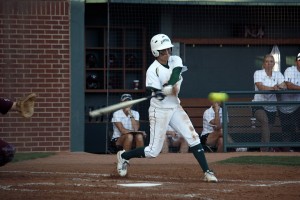
No. 5 infielder Dani Leal swings at a pitch during the Lady Bears’ game against Texas A&M on March 31 at Getterman Stadium. Baylor won, 3-2.
Canion among healed players for 2011 season
By Krista Pirtle
Sports Writer
The Lady Bears softball took the field for their first outdoor practice of the season at Getterman Stadium Tuesday.
Redshirt sophomore Whitney Canion has made her way back to the circle to help lead the team in its push toward a Big 12 Championship. The team received a sixth place ranking in the conference from the preseason coaches polls.
Canion, with an ERA of 1.58 in 11 appearances last year and 529 career strikeouts, is right on schedule with her rehabilitation after finishing last season early with a stress fracture in her forearm.
“She’s doing really well at this point,” head coach Glenn Moore. said. “I think she would say she’s full speed and ready to go. That’s just the kind of competitor she is, but we’re taking it slow. [We’ve] probably overdone it a little bit to make sure that we didn’t put too much on her arm too early. We believe, doctors believe, she’ll be ready to go by the first game, and she’s throwing the ball hard and everything looks good so far.”
With Canion warming up the heat, her teammates are ready to back her up in the field and turn some heads in the process.
“After the Big 12 standings came out … it urged us to get to the top again like we were a couple years ago when Whitney led us all the way to the super regionals,” senior infielder Jordan Vannatta said. “Everybody’s definitely in higher spirits now that she’s getting back and getting going. She was a major leader for us out in the circle.”
Last year, the Lady Bears finished the season 28-25, far below the team’s expectations; however, the way they dealt with the challenges they faced has prepared them for a better 2011 season.
“We’ve healed up a little bit from last year with five surgeries,” Moore said. “It’s kind of out of the norm for a season and with 17 kids to have five surgeries, that was our luck last year. Hopefully we’ll have a little better luck this year.”
Canion, a major name on the injured list last year, was disappointed with her inability to finish out the season but used her time on the bench to mature as a player.
“The best thing was that I matured,” Canion said. “I went out there and watched every single game. I paid attention to every single pitch. I took notes on the hitters, and I think it made me become a better player, a better pitcher, a better leader. I can help coach the team, and I think that it just helped on my mentality on the game and to see the game from the outside in really showed me what this team has and what we’re capable of.”
During the offseason, the Lady Bears wasted no time working to improve on the 2010 season and prepare for what the 2011 season holds.
“That was probably the best offseason I’ve been through during the last three I’ve been through,” Vannatta said. “We’re definitely more prepared this year than we ever have been.”
The Lady Bears understand the only way to go from their preseason rankings is up.
“We don’t need to say we’re just going to win the Big 12. We need to think past the Big 12. We need to think about the big picture and go somewhere,” Vannatta said.
BAA honors 1984 grad for work as art director at Fossil

1984 Baylor alumnus Tim Hale is one of Baylor Alumni Association’s five honorees for the Distinguished Alumni Award.
By Liz Hitchcock
Reporter
To be recognized by the college you attended could be considered one of the most endearing honors you can receive post-graduation. The Baylor Alumni Association announced its newest honorees on Friday at the Phoenix Ballroom in Waco.
Among these awards given to previous Baylor students is the most honorable – the Distinguished Alumni Award.
“These alumni represent the beacons of what Baylor continues to offer to the world,” said Mark White, the master of ceremonies for the event.
This year the alumni association gave out five Distinguished Alumni Awards and out of these alumni was Timothy Hale, senior vice president of design management and marketing for Fossil and a student from the graduating class of 1984.
Terry Roller, who teaches graphic design as an art professor, introduced Hale at the event and took the audience through his career and just how meaningful Hale has been to Fossil.
Since the start of Fossil in 1984, the company has reached $2 billion in sales and has more than 10,000 employees, Roller said, but the company started with a mere five employees and would later acquire Hale as one of them.
When Hale started his employment at Fossil, he was a member of their relatively small sales team, and would eventually become their first and, since then, only art director.
“It was Tim’s design of the iconic tin toy car packages for Fossil watches,” Roller said. “That drove the company’s early success. … He also helped promote the idea that good design is good business.”
During his acceptance speech, Hale shared stories from when he was a student at Baylor and the hidden benefits of classes unrelated to graphic design.
Hale took advanced German courses in the last semesters he attended Baylor. These courses were surprisingly helpful, for the first country Fossil was distributed to outside the United States was Germany.
“Fossil has one of the largest, best-known and highly awarded in-house art department in the United States, if not the world,” Roller said.
Hale also spoke about the art department, realizing how far it has come since he was a student.
“It’s interesting to know that when I was at Baylor, if you were an art major you would start off in the basement of the Carroll Science Building,” he said, “which told me where art stood at Baylor.”
By the time Hale graduated, he was married with two children and was working several jobs.
“It’s amazing what responsibility can do for a person’s motivation,” Roller said, “to help mold them into what they want to become.”
Hale reminisced about his childhood, mentioning a babysitter that instead of allowing him to watch television, would make him sew and participate in creative activities. Later on he credited a high school teacher for first posing the question of whether he wanted to go into art as a career.
“You don’t get here alone,” said Hale, “and I certainly didn’t get here alone.”
The four other recipients of the Distinguished Alumni Award were Dr. Gerald Cobb, graduate of 1950 and recipient of his MS in 1955, Michael Johnson, alumnus of 1990, Dr. Patricia Mathes, alumna of 1984, and Maj. Gen. David Rubenstein, recipient of his MHA in 1989.
Athlete-turned-educator shares wisdom, advice

Dr. Ken Matthews spoke on leadership in schools Monday in Kayser Auditorium during the first of the Leadership Lecture Series this semester.
By Sobia Siddiqui
Reporter
As part of this semester’s leadership lecture series, a former Baylor football player-turned-principal counseled students to stand out by making a difference in their schools.
Dr. Ken Matthews, 1984 Baylor alumnus and superintendent of schools for the School of Excellence in Education, presented his lecture as a conversation with Ashley Weaver, the project coordinator for the Greater Waco Community Education Alliance and a Baylor alumna.
Ramona Curtis, the director for Leader Development and Civic Engagement and coordinator of this event, explained the purpose for the leadership series.
“The academy for civic engagement and leader development provides the format for any student here at Baylor to participate and hear from leaders who are making a difference in their world,” Curtis said. “And hopefully that will inspire leaders, our future leaders, our students to go out and change the world around them as well.”
Matthews encouraged students to reach out and help the children in their community.
He referenced what he has been able to accomplish with the School of Excellence in Education, an organization in Texas that focuses on helping students reach their full potential.
Weaver asked Matthews what advice he had for college students who wish to become leaders.
“There’s a lot of leadership styles out there. First of all, it has to match you and who you are,” Matthews said. “I go by the transformational leadership style, which is one that challenges the status quo.”
Weaver asked Matthews what advice he would give on how students can strategically impact and give to their school.
“You’re already making a difference just by being here and saying, ‘I’m one of those that cares enough to go out into the community and make a difference’,” Matthews said.
Matthews said when dealing with adults, adolescents and especially young children, educators have to be genuine.
“They can tell when I’m telling the truth; they can tell when I’m not telling the truth,” Matthews said. “They will be able to tell the difference with you.”
Matthews said his greatest accomplishment is impacting the lives of children.
“The greatest gift was to look at a little kid, to assist him or her, and see the smile on their face, and then they come back and ask for more,” Matthews said. “Then I knew that I’d arrived, because there’s somebody in the world who wanted to listen to me.”
The first question asked by the audience was how Matthews’ transformation from a football player to an educator occurred.
“I did not select education; education selected me,” Matthews said. “I think it was higher than that. I think God selected me. I think God was telling me I want you to do for others what others did for you.”
Matthews ended the interview with a word of advice to students.
“I’m hoping today, that as I’ve spoken to you, you were actually reading my heart,” Matthews said. “You listened to what I had to say, but you were also reading my heart.”
1/26/11: The Baylor Lariat
[issuu autoFlip=true width=640 height=560 embedBackground=%23005fbb shareMenuEnabled=false backgroundColor=%23222222 documentId=110126061547-1edd8032d2f14cb096ccb5e16fd1f885 name=110126pdf username=jonangel tag=news unit=px v=2 showhtmllink=false]
Diverse Greek groups kick off rush
By Sally Ann Moyer
Reporter
The Bill Daniel Student Center Den came alive Wednesday with the activity and enthusiasm of the racial and culturally diverse members of Multicultural Greek Council organizations at their annual Meet the Greeks event. Representatives from each of the member organizations manned booths and presented brief performances showcasing the character of their organization.
Rush events are occurring this week for most of the organizations, including informational sessions, dinners, service events, karaoke and mixers.
Each performance Wednesday began with a roll-call cheer from the present members followed by a step and hip-hop style dance.
The organizations within Multicultural Greek Council are different from other campus Greek societies because they each represent a specific cultural group.
Delta Epsilon Psi is a national South Asian service fraternity.
“We’re great to help you academically and to make you grow as a person,” said Houston sophomore Delta Epsilon Psi member Roshan Patel. “That’s basically all we’re for: to have an opportunity to succeed everywhere.”
Delta Epsilon Psi raises money for the Juvenile Diabetes Research Fund. During the fall semester, Delta Epsilon Psi raised $5,000, mostly through sporting events, Patel said.
Delta Phi Omega is the largest and fastest-growing South Asian sorority in the nation, said Houston junior Delta Phi Omega member Jesley Joseph.
Delta Phi Omega hosts Literacy Through Unity week in March, including service at a local elementary school, small fundraising events and a benefit concert at Common Grounds. Everything raised goes directly to the philanthropy.
“Even though we’re small, the service we’ve been doing has impacted us,” said Katy junior Delta Phi Omega member Priyanka Mathews.
Dallas senior Isabel Teo is the current president of Alpha Kappa Delta Phi, the largest national Asian sorority in the nation.
“We really encourage sisterhood and friendship,” Teo said.
Alpha Kappa Delta Phi participates in Steppin’ Out, breast cancer awareness, fundraisers in October and events with their brother fraternity, Lambda Phi Epsilon.
The organization’s rush this semester has a princess theme, said Teo.
Omega Delta Phi is a national multicultural fraternity. Their national philanthropy is Court Appointed Special Advocates.
Kappa Phi Gamma was the first South Asian sorority at Baylor.
Houston senior and Kappa Phi Gamma member Ayman Rahman appreciates the small size of her sorority. She rushed because she “felt close to the girls.”
The organization’s largest fundraiser each year is Cancer Week in April, Rahman said.
Kappa Phi Gamma participates in social and service mixers with Multicultural Greek Council and performs and does events with Indian Subcontinent Student Association.
Sigma Iota Alpha Sorority is a service-based Latina sorority.
“We cherish our small number because of quality, not quantity,” Corpus Christi member Tara Molina said.
Sigma Iota Alpha sponsors a child from Chile through Children International, nationally supports Camp Heartland, a program for children with HIV/AIDS, and participates in different service events with other Multicultural Greek Council organizations.
The concepts of bonding and sisterhood attracted Carrollton senior Stephany Grullon to Gamma Alpha Omega.
Gamma Alpha Omega has a new philanthropy this year supporting youth and education. January is the organization’s philanthropy month, but it also participates in a variety of service opportunities throughout the year, including a soup kitchen, Salvation Army, mentoring kids and working with the Hispanic Student Association.
Kappa Delta Chi sorority is a “service and social [sorority] with an emphasis on service,” said Houston junior Kappa Delta Chi member and Multicultural Greek Council Internal Vice-President Brittany Thompson.
“All KDXs wherever are nice and just have a huge dedications to service,” said West Columbia sophomore Jedidah Guerra, Kappa Delta Chi recording secretary and sergeant-at-arms officer.
The sorority raises money for the American Cancer Society and its own KDChi Foundation.
2011 Attack of the Sweets: The year of tenacity?
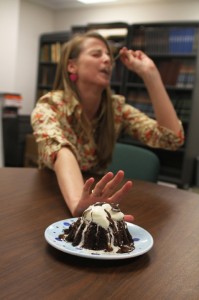
Resolved students find help in campus programs
By Molly Dunn
Reporter
Sticking to New Year’s resolutions is difficult for almost everyone, especially when the goal is to be healthier. Life gets in the way, old habits creep back and resolutions go unfulfilled. But there is hope.
Baylor offers many opportunities through programs, events, facilities and various activities for faculty and students to stay fit.
“Students need to define what their goals are,” Van Davis, assistant director for Fitness and Nutrition Education at Baylor, said. “The goals need to be specific, measurable; it needs to be something that is attainable, realistic and timely.”
When creating these goals, Davis believes the act of writing them down leads to successful results.
“One of the best things is to look and see where they are right now,” Davis said. “You need to know where you are before you can go somewhere.”
The McLane Student Life Center offers fitness assessments to measure body fat percentage, flexibility and blood pressure, helping faculty and students find out where they are right now. This makes charting progress easier, allowing students to achieve their resolution. In fact, from 3 to 5 p.m. today, the student life center is offering fitness assessments in front of the fitness center.
“We really focus on long-term and short-term goals and how important it is that you have short- term goals line up with your long-term goals so that you can eventually meet that long-term goal,” said Jennifer Spear, senior peer nutrition educator at the McLane Student Life Center.
The peer nutrition educators at the student life center offer guidance, advice and helpful tips for students who want to live a healthier life.
“We also help them modify their goals. That way they are attainable. Because one of the problems that people always have with their goals is that they set them way too high,” said Bekkah Limon, senior peer nutrition educator.
By creating short-term and long-term goals that are achievable, students can find themselves following their resolution and seeing successful results.
“A number is achievable. If you have a quantifiable amount, then you actually are able to achieve that and know that you achieved it,” Spear said.
Writing and planning fitness and nutrition goals is an important step in being successful, Davis said.
Students should use short term goals, such as spring break, to find motivation to workout, eat right and lead a healthy lifestyle. But repeating the same routine may cause the body to lose motivation and commitment, so Davis suggests that students find a variety of activities, especially with an “accountability partner” to help each other stay on track.
“Find two or three things that you enjoy doing and then spread it out across the week, because if all you do is get on the treadmill and run or walk, and that’s all you do, it gets boring,” Davis said.
At Baylor, students can participate in a multitude of activities through the 40 classes offered in bearobics, bearcycle classes, personal training and many other group or individual exercises.
This advice for fitness can also be applied to nutrition.
“You don’t have to take something completely out of your diet because it is more fattening,” Spear said. “It is all about customizing your diets so that you can live a healthier lifestyle that is tailored to your culture and your habits.”
Changing diet and workout routines does not have to be boring or a punishment. In fact, Davis said students should reward themselves after sticking with their goal for four weeks.
“Statistics show that if we set smart goals, and we keep that consistent for about four weeks, and if we have a reward system, people are a lot more successful,” Davis said.
For more information about personal training, programs at the McLane Student Life Center or about signing up for a free fitness orientation, contact Van Davis at van_davis@baylor.edu, or visit the Department of Wellness in room 305 of the student center for information on peer nutrition education.
Art scholarships, in short supply, get local boost

Fernando Salas’ painting, which won third place in last year’s scholarship contest, hangs on the wall of the Studio Art Gallery.
By Ariadne Aberin
Staff Writer
There are many opportunities for academic and athletic scholarships. The Top Young Artists Scholarship Program began because there aren’t as many opportunities for academic advancement in the arts.
The Top Young Artists of the Year is a scholarship program open to juniors and seniors in high schools throughout the county, and it was started by Lance Magid, owner of Studio Art Gallery in Waco.
“This was an idea I had about four years ago,” Magid said. “My mission was to bridge the gap between academic and athletic scholarships. We are trying to keep art alive in Waco, because we believe that art preserves culture.”
To apply for the scholarship, students submit their artwork to their teachers, who then select the top three pieces from their respective schools. The pieces are then displayed at Studio Art Gallery for two weeks.
“At that time, if the students want to sell their art, they can,” Magid said.
If a student decides to sell his or her art, the student keeps 75 percent of the profit, while 25 percent goes toward the funds for next year’s scholarship.
The scholarship winners are chosen by a panel of judges who each have different points of view on art.
“The judges change every year,” Magid said. “During our first year, we had professional artists. We’ve had professors from Baylor, TSTC and MCC judge. We’ve also had local collectors who are great art enthusiasts. This year, we plan on having an interior designer join the ranks.”
Magid explained that the scholarship contestants were judged based on a set of three criteria: creativity and originality, craftsmanship and skill, and composition and design. Scholarship winners receive prizes ranging from $250 to $2,000.
“We want every participant to leave with something,” Magid said. “We have the art teachers put together goody bags for each student, and we give out the T-shirts, art supplies, portfolios and anything we can give to help them.”
The scholarship program became popular about two years ago, when Studio Art Gallery collaborated with the Greater Waco Chamber of Commerce.
“The Chamber of Commerce has helped us out tremendously,” Magid said. “They really pushed this event, and we could not be happier with what the chamber has done to help us.”
Alexis Weaver, director of community affairs for the chamber, explained why the Chamber agreed to work with Studio Art Gallery:
“There have been a lot of funding cuts in the city lately,” said Weaver. “When it comes to students being gifted in the arts, not as much is available and that’s not really where a lot of students are encouraged, and those are the programs that get cut more often.”
Weaver added that Studio Art Gallery felt that the chamber would be a good partner because of its community development and connection to Waco ISD.
Through the help of the chamber, the scholarship program is now sponsored by companies such as Providence Healthcare and Hillcrest Baptist Medical Center. This year, Oak Farms Dairy in Waco is the main sponsor for the scholarship program.
“Our goal is to get this program as big and as best as we can do it,” Magid said.
At the end of the two week art exhibition, an awards ceremony is held at Art Center Waco.
“It’s nice because after the ceremony, the students can say that their art hung in an internationally recognized museum,” Weaver said.
Marc Arnold, director for Art Center Waco, said a representative from the chamber and several local business owners show up to the event.
According to Magid, the 2008 grand prize winner, Kelsey Truman, still comes back to work during the summer and breaks. Truman attends college at Georgetown, and the gallery has helped her get commission work. The 2008 third place winner, Fernando Salas, enlisted in the United States Marines two weeks before the scholarship competition started. Because the military would pay for his education, Salas donated his winnings to the program’s scholarship fund.
The students’ artwork goes on display at Studio Art Gallery on March 15. Studio Art Gallery is located at 4712 West Waco Drive. There is a wine-and-cheese preview the night before the first exhibition day, open to the public, and the awards ceremony is also open to the public. The awards ceremony will take place at 6:30 p.m. March 28 at Art Center Waco. For more information, contact Lance Magid at Studio Gallery, studiogallery@hotrr.com.
Reaction to climate ‘shocks’ studied
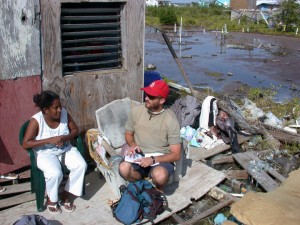
Steve Cole, a graduate student at the University of Arizona, surveys a local Belizean while conducting field research in Belize.
By Jade Mardirosian
Staff Writer
A Baylor associate professor’s recent study in Belize examines how people and communities respond to climate change and natural disasters. Results from the study indicated that secure households are able to respond more effectively to climate change and disasters.
Dr. Sara Alexander, associate professor of anthropology at Baylor, conducted research in three coastal communities in Belize using a range of about 860 various households as test samples.
Alexander and her team focused on coastal communities with varying degrees of dependency on tourism, identified vulnerable households in these communities and tested how these households respond to a climate related event or shock.
“One of our hypotheses was that the more socially connected a household is to their local community, the less vulnerable they are in terms of these climate variables,” Alexander said.
Over the past year Alexander has been processing and analyzing the data and has found things in her preliminary results that indicate that 62 percent of households believe chronic weather conditions, such as increased temperatures and floods, are of higher concern than an isolated disaster, such as a hurricane.
“Their perception isn’t necessarily that this ‘one off’ disaster is more severe in terms of their lives,” Alexander said. “That was interesting because I really thought that in this area you have mostly tropical storms and hurricanes and mudslides, and I thought those sort of events would give people the perception that they were more serious than things like a drought.”
Further results indicated that many households have a strong perception of global climate change, with 57 percent of households believing that storms are currently harsher than they were 5 to 10 years ago.
The results will be published in the Climate Change and Mitigation and Adaptation Strategies for Global Change.
The study was funded by way of a $235,000 grant from the National Oceanic and Atmospheric Administration.
Dr. Susan Stonich, professor of anthropology at the University of California, Santa Barbara, worked as co-investigator on the research. The research team also consisted of doctoral students from the University of California, Santa Barbara and the University of Arizona. Once in Belize, Alexander hired Belizean high school and college students to help with conducting surveys in the community.
Those that worked with Alexander on the research are currently conducting other research (not associated with the work done in Belize), out of the country and could not be reached for comment for this article.
Alexander is currently working on proposals for a stage two of research, studying the same factors, but expanding the locations to the Yucatan and the Northern coast of Honduras.
Dr. Joseph White, associate professor of biology, is currently working with Alexander on preliminary steps for this research. White says they are planning on developing a research grant for the National Science Foundation.
“Currently the idea is to leverage the work [Alexander has] accomplished in Belize,” White said. “This would be a follow up, at this point taking a look at the combination of how agriculture and coastal reef fisheries are connected due to climate and how people using farms or fisheries are perceiving changes in their food supply and their potential relationship to climate change as it has been occurring.”
White explained that he would be predicting future environmental changes based on computer modeling and Alexander would assess if humans are aware of changing conditions to the climate.
Men fall to 3-3 in Big 12
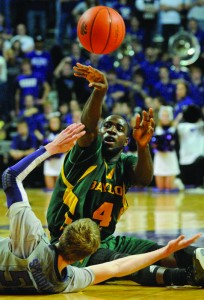
No. 4 junior Quincy Acy passes to a teammate after diving for a loose ball in Monday’s game against Kansas State. The Bears lost, 69-61.
By Chris Derrett
Sports Editor
Baylor could not overcome a sloppy first half and dropped its Monday night matchup at Kansas State, 69-61. Junior Quincy Acy led the Bears with 14 points, and three others finished in double figures.
Baylor shot 56 percent in the second half and drained four 3-pointers in the period, but it was not enough to get a win on ESPN’s Big Monday.
“You need to do it for two halves, not one,” coach Scott Drew said.
A second half surge from the Wildcats (14-7, 2-4) erased a brief Baylor (13-6, 3-3) lead and created a deficit the Bears could not overcome.
After freshman Stargell Love hit a 3-pointer from the corner and put the Bears ahead 30-29, Rodney McGruder answered with his own three for a 32-30 Kansas State advantage. Love hit a free throw on the other end before three consecutive Wildcat buckets capped an 11-1 run.
The final basket of the run came after McGruder dashed in from the 3-point line to snag an offensive rebound from four Bears under the rim. McGruder kicked the ball outside the arc to Jacob Pullen, who drained a trey that sent the Manhattan, Kan., crowd into a frenzy and forced a Baylor timeout.
The offensive board was one of 16 from the Wildcats en route to beating Baylor 35-26 in the rebounding category.
“That area, the rebounding, really was the most disappointing on our coaching staff’s thoughts,” Drew said.
Love was among the double digit scorers, tallying 11 points in an unexpected 18 minutes of play. The Bears called on the backup point guard after sophomore A.J. Walton picked up his fourth foul four minutes into the second half. Walton reentered the game at the 9:59 mark but lasted only nine seconds before fouling out.
“I was pleased with how he [Love] performed and pleased with his effort,” Drew said.
Love’s 18 minutes are the most he has played since starting in place of Walton in Baylor’s Nov. 12 season opener against Grambling State. His 11 points set a new career high.
“It’s all because of the coaches. The coaches teach us, coming in [to the game] to be calm,” Love said.
Just before Walton picked up foul number four, he had hit back-to-back threes to tie the game at 27 with 17:56 to go in the game.
The Bears entered the locker room down 25-18 as neither team broke the 30 percent shooting barrier. While Baylor struggled to 6 of 24, Kansas State missed seven layups as part of a 9 of 28 half.
Foul trouble also hurt the Bears, as Drew started junior J’mison Morgan in place of junior Quincy Acy for Morgan’s defensive presence. The strategy was hindered with four fouls from Morgan before the halftime buzzer.
Senior LaceDarius Dunn also had a quiet game. Dunn scored 13, tying his Jan. 17 performance against Kansas for a season-low point total.
Freshman Perry Jones III strayed from his Big 12 average 19.8 points entering Monday night and notched just 11.
Lady Bears beat Tech, learn lessons
By Matt Larsen
Sports Writer
It was anything but pretty, but the No. 1 Lady Bears outlasted Texas Tech 64-51 Saturday night in a battle fought and won in the paint and on the boards.
“I’m most disappointed in the number of offensive boards we allowed Texas Tech to have,” head coach Kim Mulkey said. “That’s just pure grit.”
The Lady Raiders outrebounded the Lady Bears 36-32 overall, with 17-9 on the offensive side.
Tech began work down low early, pulling down six offensive rebounds before Brooklyn Pope hauled in her squad’s first offensive board with 11:53 left in the first half.
While her team held onto a lead the majority of the first half and virtually the entire second, Mulkey saw the youth in her team’s faces during a timeout.
“You would have thought that we were down,” she said, staring at daunted eyes. “Smile. Compete. This is what you get with that No. 1 on your chest.”
In addition to lacking their usual inside presence as they managed just three offensive boards in the first half, the Lady Bears missed a certain outside presence for most of the first half as well.
“Not having Odyssey [Sims] on the court, you try not to think about. You try to keep playing,” sophomore post Brittney Griner said. “But we all like her having that pressure out there on the ball.”
With two early fouls Sims went to the bench with over 15 minutes left in the first half.
While her team missed her on the defensive end, the scoreboard revealed that the Lady Bears also missed their second-leading scorer.
The team’s No. 1 scorer this season, Griner, went to the locker room with a typical 15 points.
Her team, however, still trailed 29-28.
It was the first time Baylor trailed at halftime since it played then-No. 1 Connecticut Nov. 16.
With Sims back on the floor to start the second half, the Lady Bears used a 9-3 run to take the lead.
Griner, sophomore Destiny Williams and sophomore Brooklyn Pope regained ground under the basket on their way to seven, eight and six rebounds respectively.
Griner led her team with 25 points on the night and a crucial pair of finishes in the paint that allowed her team to tie and then take the lead for the final time early in the second half.
Tech kept it close though, using an 8 point run just before the five minute mark to pull within seven and make it 53-46.
Senior Melissa Jones ended that streak with a couple of free throws and a few minutes later sank a three that stretched the lead to 60-51 with just over a minute to go, putting the game out of reach.
“Just scoring period at that point was big,” Mulkey said.
Jones tallied 13 points to finish behind Griner as the Lady Bears second-leading scorer.
“Between those two,” Tech head coach Kristy Curry said following the game. “They always seem to make a play when Baylor needs it most.”
New Baylor production brings both laughs and depth
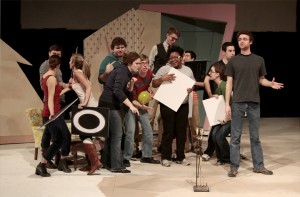
“The Skin of our Teeth” is performed by students of Baylor Theatre Monday in the Mabee Theatre.
By Bonnie Burger
Reporter
Audiences can expect laughs, engaging scenes and active participation from the Baylor Theatre’s newest production, “The Skin of Our Teeth,” opening at the Mabee Theatre at 7:30 p.m on Feb. 1.
Shelby Hibbs, a graduate student from North Little Rock, Ark., is directing the dramatic comedy depicting the bizarre adventures of the Antrobus family in the face of impending doom.
“Each act is its own little world,” Hibbs said. “It’s not a linear progression of events. Jumping from one act to the next, there are many stories being told.”
The story settings include the Ice Age, Great Flood and a throwback to the Roaring Twenties.
A mixture of humor and intensity, overshadowed with strong biblical themes, the play purposely draws in the audience.
Hibbs alluded to specific roles the audience plays, careful to leave hints of curiosity and ambiguity.
“Unlike other theater performances, you will use your cell phone,” she said.
The nature of the production calls patrons to action, at times drawing onlookers onstage with the actors.
“We want to see if we can build a community of people throughout the audience,” Hibbs said. “It’s rewarding to have the opportunity to take that risk. It’s also rewarding if that risk pays off.”
This risk also allows for every production to have an element of improvisation.
“Concerning audience participation, there’s an unknown of what’s going to happen, how that person is going to react or interact with you,” said Richard Ross, a Dallas sophomore playing the part of Mr. Antrobus. “This play is all about breaking boundaries between the audience, the performance and the actors.”
The play is part of Hibbs’ thesis for the Master of Fine Arts directing program. She first encountered “The Skin of Our Teeth” as an undergraduate student at Ouachita Baptist University in Arkansas.
During her thesis preparation, Hibbs returned to the script she found “hysterical and fascinating,” after reading more than 60 scripts.
“The play has more substance to it,” she said. “It portrays ideas of human community, spirit, myth, progress and defining what progress is.”
In addition to the play’s comedic element, patrons can expect depth to each character.
“It’s been fun to dissect [my] character,” Ross said. “Mr. Antrobus is a representation of man, an Adam figure, with this great flaw. He’s trying to cover this flaw by righting the world.”
Hibbs strove for a collective collaboration between herself and the actors, often drawing from their feedback and pursuing collaborative research together.
“Shelby has been a real creative and experimental leader with the production,” said dramaturg and theater historian Dr. DeAnna Toten Beard. “I think everybody is finding the work to be very rewarding.
Thornton Wilder wrote the Pulitzer Prize-winning play, which opened on Broadway in 1942.
“[The audience] will find it to be unpredictable and not exactly what they’re used to, in a good way,” Toten Beard said. “I think they can expect to be surprised and to laugh a lot and to have their thinking really challenged in a positive way.”
“The Skin of Our Teeth” runs nightly through Feb. 5 at 7:30 p.m., with two matinee performances at 2 p.m. Feb. 5 and 6. Tickets are available at the Baylor Theatre Box Office for $15.
Tennis fights frost for the win
By Will Potter
Reporter
A frigid blast of winter weather chilled Central Texas, forcing the seventh-ranked Baylor men’s tennis team to move the match to Lion Tennis Center in Ennis last Thursday.
Neither the cold temperatures nor the change of venue could stop the Bears from dominating Louisiana-Lafayette from start to finish.
“The season is an adventure, and that was just another chapter in our adventure,” Matt Knoll, head coach, said about the match being moved. “Our guys did a great job of maintaining focus, poise and high intensity throughout the match.”
The Bears took control of the dual match early on by sweeping all three of the doubles matches versus the Ragin’ Cajuns.
Baylor’s fourth-ranked tandem of Roberto Maytin and John Peers methodically picked apart Yanick Mandl and Brandon Farine, taking No. 1 doubles by a score of 8-5. Julian Bley and Kike Grangeiro of Baylor defeated Oscar Pachon and Carl Alberton handily, 8-3.
At the No. 2 spot for Baylor, senior Sergio Ramirez teamed up with Jordan Rux to defeat Ted Nilsson and Carlin Murray from Lafayette in a nail-biter, 8-7.
Rux and Ramirez were down 7-6 with a match point when they broke Nilsson and Murray to tie the match at 7-7. That tie forced a tiebreaker that the Bears won 7-3 to sweep through doubles.
“Sergio and I each played well at different times during the match,” Rux said, “but when we went down match point we just synced up, made good returns and ended up pulling it out.”
After sweeping all of the doubles matches versus Louisiana-Lafayette, Baylor did not let up.
In singles play, Baylor dominated as Ramirez was first off the court with a 6-3, 6-2 win against Brandon Farine at the No. 3 spot. At the fourth spot, Maytin handily defeated Ted Nilsson 6-3, 6-1.
John Peers, ranked No. 22 in the nation, closed out the Ragin’ Cajuns with a hard-fought 7-6(5), 3-6, 6-1 victory over Carlin Murray ,securing the Bears’ win.
“Once we got on top of them we continued fighting hard and just finished off the match,” Peers said.
Baylor won both the final matches in dominating fashion when Julian Bley beat Minvielle 6-0, 6-2 and then Kike Grangeiro dismantled Oscar Pachon 6-1, 6-1.
Baylor now holds a seven-match winning streak over Louisiana-Lafayette and has the overall lead in the series, 8-5.
“It was a pretty good start even though we had to travel to Ennis,” Knoll said. “I think that we have an incredible amount of momentum for this time in the season.”
The No. 3 ranked women’s tennis team opened their first dual match action of the season with a 6-1 drubbing of the Houston Cougars.
Baylor took an early lead in doubles as Sona Novakova and Diana Nakic won 8-2 at the No. 1 spot. On court two, Jelena Stanivuk and Nina Secerbegovic dominated their match 8-1. The No. 3 tandem of Aya Bara and Abby Stainback lost 8-7 (8-6) after an arduous battle.
“I was really pleased with the way we played at one and two doubles,” Joey Scrivano, head coach, said. “Also, anytime you can get in a position where you have match point that is a good thing. Our No. 3 team just needed to finish it off.”
In singles action, the Lady Bears took care of business from top to bottom.
At the No.1 spot, Diana Nakic gave up only one game and won in straight sets over Dionne Sanders, 6-1, 6-0. Playing No. 2 for the Bears, the 19th nationally ranked Sona Novakova dismantled Bryony Hunter, 6-0, 6-2. Aya Bara beat Maja Kazimier 6-3, 6-0.
“We have a lot of collegiate tennis experience with our top four girls,” Scrivano said. “We were obviously the better team and when you’re the better team it is all about staying focused and finishing off your opponent.”
The Lady Bears had no problem finishing as Jelena Stanivuk easily won 6-1, 6-1 over Jo Garvey and 40th-ranked Nina Secerbegovic rolled in straight sets 6-0, 6-4, over Girogia Pozzan to secure the victory for the Lady Bears.
The Baylor women’s tennis team did not drop a set to the Houston Cougars in their victories and controlled this dual match from start to finish.
The Lady Bears take on Alabama at 11 a.m. Saturday at the Baylor Tennis Center.
Accused Arizona gunman pleads not guilty
By Jacques Billeaud
PHOENIX — The suspect in the shooting of Rep. Gabrielle Giffords smiled and nodded but didn’t speak as he appeared in court Monday and his lawyer provided the 22-year-old’s first response to the charges: a plea of not guilty.
In the two weeks since the deadly attack that killed six outside a Tucson grocery store, Jared Loughner’s hair — shaved in the mug shot that’s become an enduring image of the tragedy — has grown out slightly.
The Tucson resident wore an orange prison jumpsuit and glasses, and his wrists were cuffed to a chain around his waist as eight U.S. marshals kept watch in the packed Phoenix courtroom and gallery above.
Loughner faces federal charges of trying to assassinate Giffords and kill two of her aides. More charges are expected.
Investigators have said Loughner was mentally disturbed and acting increasingly erratic in the weeks leading up to the attack on Jan. 8 that wounded 13.
If Loughner’s attorney uses mental competency questions as a defense and is successful, Loughner could be sent to a mental health facility instead of being sentenced to prison or death.
Giffords was shot in the forehead and spent two weeks in a Tucson hospital before she was flown to Memorial Hermann Texas Medical Center Hospital on Friday.
Shortly after her arrival, doctors said she had been given a tube to drain a buildup of brain fluid that has kept her in intensive care.
Loughner will likely face state charges in the attack, and also federal murder charges listed in an earlier criminal complaint for the deaths of Giffords aide Gabe Zimmerman and U.S. District Judge John Roll.
Those are potential death penalty charges, which require a more painstaking process under Justice Department rules.
Editorial: Manually updated system not enough for true campus safety
Baylor displayed a major flaw in its emergency alert system last Monday when 4,800 students did not receive a notification regarding the presence of two armed men on campus.
At 11:15 p.m., Baylor’s alert system was activated when two men being pursued by both Waco police and Beverly Hills police for the robbery of two cash stores near the Baylor campus.
The suspects ran from Casa Royale, on Speight Avenue, to the intersection of Eighth street and Speight Avenue, where they separated, one running toward I-35 and the other running toward La Salle.
The alert sent to Baylor students via text message, automated phone call and e-mail said: “Two black males, 1 wearing a black shirt and 1 wearing a white shirt, armed and thought to be on campus. Please remain inside until further notice.”
A file missing thousands of students’ names and emergency contact information in Baylor’s system served as the database for last Monday’s alert notification system. This was a grave error displayed in the Baylor alert system.
The swift action officials took in notifying the Baylor community was commendable. Waco and Baylor police worked together to quickly alert students, and had the system been completely accurate, it would have easily notified all students with impressive promptness.
There is an importance in pointing out how helpful the alert system was to many students that night. With incidents similar to last semester at University of Texas at Austin, where a lone gunman committed suicide on campus, or the tragedy at Virginia Tech that left 33, including the gunman, dead, it is of vital importance that college campuses have a timely and efficient method of alerting students.
Our university should not wait for a tragedy like the on-campus suicide in Austin before we improve our alert system.
A manually updated system is no longer effective for the times we are in and the move to a fully automatic, self-updating system is crucial.
While the incident that occurred last week was fortunately not an attack directed at students, it could easily have been, and the flaw in the alert system could have cost a number of lives. Beside the system improvement, the university should consider other avenues to increase our on-campus safety.
For instance, key-card swipes on the outside of buildings would have prevented the two men from entering a building, thereby protecting students and allowing police to narrow down the search area. Small but powerful changes such as this should be considered. The swipe of a card is an inconvenience we presume many would take on for increased safety.
Baylor must patch this hole in the system, and it appears the school has every intention to do just that. Much can be learned from this unfortunate situation that can ensure the safety of students in the future. Baylor reports progress, and the Lariat applauds the quick turnaround.
While tensions ran high, we were given the chance to truly test our system, and we should recognize last Monday’s manhunt as a blessing in disguise.
Point of View: U.S. world titles should include other countries
By Amanda Earp
I love football — specifically the NFL.
My team is the Indianapolis Colts. I have loved them since I watched my first Colts game in 2006 when they played the New York Giants.
It was Manning brother versus Manning brother and the first NFL game, beside different Super Bowls, I remember actually wanting to watch. I followed them the whole 2006 season and watched them win the Super Bowl; I was hooked on the Colts and the NFL in general.
Fast-forward to 2011 and I watch more football now than some of my guy friends. It is probably my favorite thing to watch on TV and anytime I can watch it, I will.
I was watching a Monday night game back in December when the New Orleans Saints played the Atlanta Falcons.
I’m going to digress before I get any further into this story and admit that, yes, I am still bitter about the Saints beating the Colts in the Super Bowl last year.
Extremely bitter.
For example, when I see someone wearing anything relating to the Saints I still get upset like the game happened last night.
As I was watching the Saints and Falcons game, the announcers kept calling the Saints the “world champion.”
This bothered me, not because I am an angry Colts fan — which, granted, I am —but because the Saints should not be considered the world champions.
They are champions, but they would be considered the national champions because the NFL is the National Football League. How can we consider a team to be the world champion if they only play teams in the United States?
The only team we should call the world champions in “football” would be Spain because they won the 2010 FIFA World Cup.
I could not figure out why an announcer would give them this title, so I texted a friend for his thoughts on the subject.
He replied that it was probably a marketing phrase used to make the game sound more important than it is and he, of course, followed with a joke about the Saints beating the Colts.
This got me thinking about other leagues in our country that have claim on world championships: baseball and the World Series to be particular.
The Giants would not be considered the world champion; South Korea would currently be the champion for winning the 2008 Summer Olympics.
I would be a little more lenient with this term being applied to baseball because of the Toronto Blue Jays, but I still do not think just including Canada is grounds to be called world champions.
My thoughts on this apply to basketball as well. The United States would be considered the basketball world champion for winning at the last summer Olympics, not the Los Angeles Lakers.
This title makes the United States sound arrogant by claiming when a team wins the national championship they are, in fact, world champions of the sport.
As someone who is going to make a career out of dealing with word choice, I find this extremely annoying.
Even when my beloved Colts win another Super Bowl, or so I hope they do, I will not refer to them as the “world champion.”
Amanda Earp is a graduate student from New Waverly and the copy desk chief for the Lariat.
Point of View: Netflix’s appeal diminishes as profit trumps all
A month into my college career, a professor began class by discussing Netflix. I knew about Netflix, of course, but I had never seriously considered becoming a member.
The more I thought about joining, the more it made sense. I could certainly afford $9 a month (which got me as many DVDs as I could watch and mail back, and unlimited streaming ability), I had plenty of free time and there were hundreds of movies I wanted to see. Plus, Netflix’s convenience and massive selection blew Blockbuster out of the water.
I pulled the trigger and signed up. More than three years later, I’m glad I did. As I prepare to graduate, Netflix has been one of the constants of my Baylor experience. It doesn’t matter if I’ve lived in Penland, North Village or an apartment– I’ve fetched those iconic red envelopes out of my mailbox every week.
I’ve rented 215 movies. Do the math and that comes to about $1.80 per movie. Not a bad deal. That doesn’t include all the value I’ve gotten out of Netflix’s instant streaming service. I’ve blitzed through entire seasons of “Lost,” “Dexter,” “The Office,” “Friday Night Lights” and more on my laptop, without being forced to watch annoying ads like on Hulu.
When I was a sophomore one of my assignments for speech class was to convince my classmates to invest in a company. I chose Netflix, not because I’m an expert on stocks, but because I wanted to research a company I actually liked and believed in. At the time, the Netflix stock was selling for about $46.
I hope my classmates were listening carefully. Recently heralded by Fortune Magazine as “the stock of the year,” Netflix’s stock has rocketed up more than 200 percent since last January.
Shares now sell for about $182. For all the company’s success, Netflix CEO Reed Hastings was named Businessperson of the Year by Fortune.
But this isn’t a love letter to Hastings and his company. As much as I like Netflix, recent moves by the company have me concerned.
A year ago Netflix began signing deals with major film studios, like Warner Bros. Entertainment, agreeing to delay the studios’ DVD and Blu-ray releases for 28 days to give the studios more time to sell before customers can rent the discs. In exchange, Netflix got access to more titles from Warner’s catalog for customers to view online.
This setback has proven to be incredibly annoying. Before the change, getting brand new DVDs in the mail on the day they were released was a thrill. Now, many of the most popular titles, like “The Social Network,” are withheld from customers for the first month of their release, which is exactly when most customers want to watch them.
What’s more, prices have been raised. My plan jumped a dollar to $10 a month, before tax. That’s not enough to make me cancel my subscription – yet – but it doesn’t bode well for the future.
Most recently, Netflix announced it was removing customers’ ability to manage their DVD queues on their digital devices, like iPhones. The logic behind the move? Netflix is trying to encourage customers to stream more content via its “watch instantly” feature – and rent fewer physical DVDs through the mail. That’s because Netflix knows that instant streaming is the future of movie and television viewing. In 20 years, everyone will be using the Internet to stream content directly to their televisions.
The catch is that Netflix’s library of films and TV shows available for instant streaming pales in comparison to its DVD library.
To be fair, the company has improved its instant streaming selection over the years, but not nearly enough to begin shifting its core business from physical DVDs.
I’m not alone in my frustration. Angry customers have stormed blogs and Netflix’s Facebook page to voice their displeasure.
Netflix may have enriched my college years and provided endless hours of entertainment and distraction, but if the company forgets what made it so popular in the first place – listening to customers – then it’s going to lose at least one subscriber: me.
James Byers is a senior business journalism major from Indianapolis. He is the news editor for the Lariat.
Health on the brain
Baylor Health Services is taking over Dr Pepper Hour at 3 p.m. today in the Barfield Drawing Room in the Bill Daniel Student Center. Come meet some of the providers and staff from the health center, counseling, pharmacy, physical therapy, wellness and members of the Student Health Advisory Committee.
Serve in the kitchen
Campus Kitchen cooking and delivery shifts start back up today. Show up in the Family and Consumer Sciences parking lots at 3 p.m. every week day to help out with dining hall pick-up and delivery, or come to the kitchen in the FCS building at 3 p.m. today or Thursday to help out with food preparation.
1/25/11: The Baylor Lariat
[issuu autoFlip=true width=640 height=560 embedBackground=%23005fbb shareMenuEnabled=false backgroundColor=%23222222 documentId=110125063941-449cfcbd362148c7a1b8aebbc2bf66d5 name=110125pdf username=jonangel tag=news unit=px v=2 showhtmllink=false]
Griner, Jones help secure 64-51 win over Lady Raiders
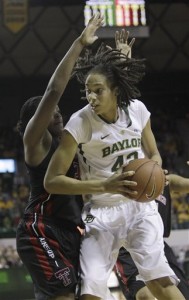
No. 42 sophomore Brittney Griner looks to shoot against Texas Tech's Kierra Mallard during the first half of the game in Waco.
By Matt Larsen
Sports writer
It was anything but pretty, but the No. 1 Lady Bears outlasted Texas Tech 64-51 Saturday night in a battle fought and won in the paint and on the boards.
“I’m most disappointed in the number of offensive boards we allowed Texas Tech to have,” head coach Kim Mulkey said. “That’s just pure grit.”
The Lady Raiders outrebounded the Lady Bears 36-32 overall, and 17-9 on the offensive side.
Tech began work down low early, pulling down six offensive rebounds before Brooklyn Pope hauled in her squad’s first offensive board with 11:53 left in the first half.
While her team held onto a lead the majority of the first half and virtually the entire second, Mulkey saw the youth in her team’s faces during a timeout.
“You would have thought that we were down,” she said, staring at daunted eyes. “Smile. Compete. This is what you get with that No. 1 on your chest.”
In addition to lacking their usual inside presence as they managed just three offensive boards in the first half, the Lady Bears missed a certain outside presence for most of the first half as well.
“Not having Odyssey [Sims] on the court, you try not to think about. You try to keep playing,” sophomore post Brittney Griner said. “But we all like her having that pressure out there on the ball.”
With two early fouls Sims went to the bench with over 15 minutes left in the first half.
While her team missed her on the defensive end, the scoreboard revealed that the Lady Bears also missed their second-leading scorer.
The team’s No. 1 scorer this season, Griner, went to the locker room with a typical 15 points.
Her team, however, still trailed 29-28.
It was the first time Baylor trailed at halftime since it played then No. 1 Connecticut Nov. 16.
With Sims back on the floor to start the second half, the Lady Bears used a 9-3 run to take the lead.
Griner, sophomore Destiny Williams and sophomore Brooklyn Pope regained ground under the basket on their way to seven, eight and six rebounds respectively.
Griner led her team with 25 points on the night and a crucial pair of finishes in the paint that allowed her team to tie and then take the lead for the final time early in the second half.
Tech kept it close though, using an 8 point run just before the five minute mark to pull within seven and make it 53-46.
Senior Melissa Jones ended that streak with a couple of free throws and a few minutes later sank a three that stretched the lead to 60-51 with just over a minute to go, putting the game out of reach.
“Just scoring period at that point was big,” Mulkey said.
Jones tallied 13 points to finish behind Griner as the Lady Bears second-leading scorer.
“Between those two,” Tech head coach Kristy Curry said following the game. “They always seem to make a play when Baylor needs it most.”








